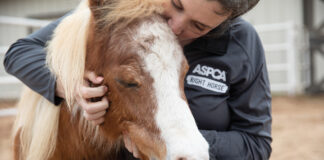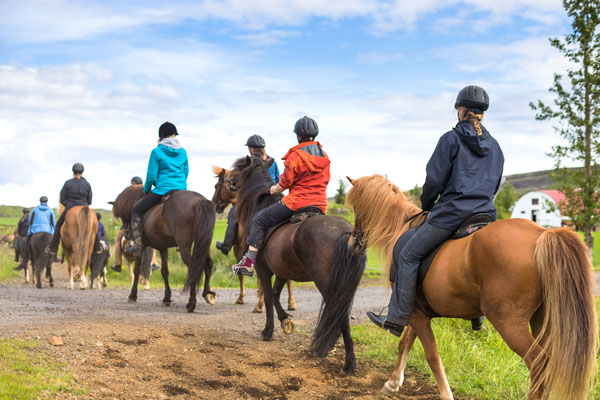
Trail riding is a fun opportunity to form a lasting bond with your horse while taking in the beauty of the surrounding landscape. The last thing you want to think about is what could go wrong, but even the most casual ride can result in calamity. If it happens to you, you’ll be glad you took the time to plan ahead. Here are a few things to consider before hitting the trail and steps you can take to be prepared to deal with trail riding emergencies.
You may begin your ride with clear blue skies, but inclement weather can pop up unexpectedly. Pack a cantle bag with weather protection: rain jacket with hood, down vest or polar fleece pullover, gloves, and a light hat or ear covers.
It’s also a good idea to pack some matches or a lighter, a small flashlight, and a space blanket. Most of these items are fairly lightweight and fit in a cantle pack. Make sure your cell phone is well charged and keep all emergency numbers up-to-date in your list of contacts. Be sure to wear your helmet, too.
Packing a basic first-aid kit is always recommended. Just a few simple supplies can make the difference (see “First-Aid to Go” below).
First Aid to GoA more expanded first-aid kit is appropriate at home or in the trailer, but since you’re likely space challenged on the trail, here are a few things to pack in your saddlebag in case of trail riding emergencies. The basics, even for short rides close to home: Highly recommended: |
A few of the suggested items in the first-aid kit will require advice from your veterinarian for proper use.
What kinds of trail riding emergencies might develop on trail?
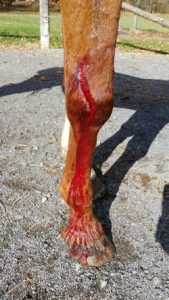
Lacerations or Puncture Wounds
While leg boots provide some protection, lacerations and puncture wounds are common, especially when riding on wooded and/or rocky trails. When possible, use salt water (½ tablespoon of salt per quart of water) in a syringe to irrigate the wound, apply topical antibiotic ointment, and bandage.
It’s not always possible to immediately wash out the wound, but covering it with a light bandage prevents further wound contamination.
Most wounds don’t bleed profusely unless an artery or vein has been cut. If bleeding persists, make a pressure bandage by rolling up a piece of gauze, applying it over the wound and securing it in place with adhesive bandage material.
It takes at least 12 minutes for blood to clot, so don’t be tempted to keep looking at the wound to see if the bleeding has stopped. It is best to leave it alone and keep your horse standing quietly.
Muscle Cramps or Tying Up
Muscle cramps, also called tying up or myositis, typically develop in the large muscles of the haunches or thighs, making it uncomfortable enough that your horse won’t want to move.
At first, you may feel an uneven or shortened stride, or your horse may show a more obvious hitching lameness. Some horses are very sensitive to muscle pain, and along with sweating may become more demonstrative, going to the ground as if in colic pain.
Muscle cramps can develop due to dehydration, overheating, or because a horse looses an abundance of electrolytes (body salts) from lengthy periods of sweating during hours of exercise. Also, sudden cool or wet weather might chill the muscles, leading to cramps.
Horses afflicted with equine polysaccharide storage myopathy (EPSSM) can also cramp; eliminating grains and feeding a high-fat diet best manages this syndrome.
If your horse develops cramps, let him rest by the side of the trail to graze and drink when possible. A 2-ounce dose of electrolytes might be helpful, especially following a good drink. A light massage may help unkink knotted muscles. If there is a cold wind or wet weather, cover his haunches with a rump rug, blanket, or warm jacket if available.
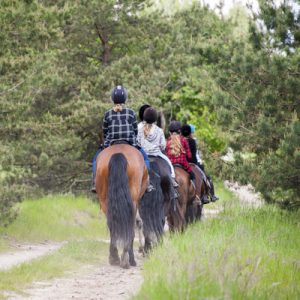
Tendon Strain and Sprain
A tendon injury can happen unexpectedly as a result of muscle fatigue or if a horse jams his leg while still moving forward. If there is a cold, running creek nearby, stand your horse in it for half an hour or so to lessen the inflammatory response that creates swelling and pain.
If you have a non-steroidal anti-inflammatory drug (NSAID like phenylbutazone, flunixin, or firocoxib) in your emergency kit, you can give him a small dose based on your vet’s prior recommendation.
Hand-walk your horse back to the trailer or the barn and call your vet. Apply an ice boot or whatever cold therapy you have available to the tendon injury once you reach the barn while waiting for your vet.
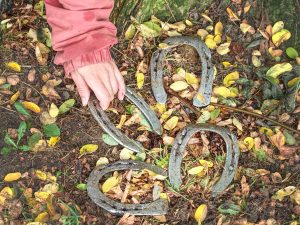
Loose or Pulled Horseshoe
Hopefully your multi-tool has a file on it to rasp away the nail heads that secure your horse’s shoe to his hoof. A pair of pliers in your cantle bag is helpful to pull off the shoe.
Work with your farrier in advance so you know the correct way to pull a shoe without ripping off too much hoof wall. Most horses do fine barefoot for a short distance, especially behind, but front feet do better if protected with a boot after losing a shoe. Have a hoof boot fi t for your horse in your emergency kit.
Choke
Choke is caused by an obstruction in the esophagus, and usually occurs when eating dry food or horse cookies. A dehydrated horse is more likely to develop choke due to reduced saliva production. Green grass with its high moisture content is not usually the culprit. A choking horse coughs and gags repeatedly, often spewing green, frothy material from his nostrils. He may act colicky or distressed.
Choke is one of the true trail riding emergencies, requiring immediate veterinary intervention, so call for help or make your way to your trailer or barn as quickly as possible. A short-acting sedative given to your horse may relax esophageal muscles enough to allow passage of the obstruction. Be sure to withhold food and water until the choke is fully resolved.
Colic
One of the most concerning trail riding emergencies would be colic. Colic simply describes abdominal pain. Its signs take many forms:
◆ The horse doesn’t want to eat.
◆ Rather than drinking, he just plays with the water.
◆ He rolls his upper lip in the flehmen response.
◆ He may paw the ground and/or kick at his belly.
◆ He lies down quietly and/or starts to roll and thrash.
Pain causes an increased heart rate (more than 44 beats per minute), and often the respiratory rate is also elevated (more than 20 breaths per minute).
Mucous membranes should be pink, and capillary refill time less than two minutes; any deviations from normal are important to note.
Intestinal sounds may be diminished or could be overly active. You’ll need the stethoscope in your first-aid kit to monitor heart rate and gut sounds. Report information about vital signs to your vet once you make contact.
Pain causes an increased heart rate (more than 44 beats per minute), and often the respiratory rate is also elevated (more than 20 breaths per minute).
Some colic conditions, like gas colic, may resolve if you longe your horse for 10 to 15 minutes at a vigorous trot. If this doesn’t help, you may need to use the sedative in your first aid kit. Give it to your horse and head for the trailer or the barn to call the vet. Refrain from giving Banamine (flunixin) unless you speak to your vet and get the go-ahead to do so.
Eye Injuries
If your horse is squinting or there is tearing from the eye, he may have been hit in the eye by foliage or dirt and debris that scratched the cornea. This is where the non-steroidal eye ointment in your first-aid kit comes in handy.
These are just a few of the more common trail riding emergencies you may encounter. The best medicine is always to be prepared.
This article on trail riding emergencies originally appeared in the August 2019 issue of Horse Illustrated magazine. Click here to subscribe!




